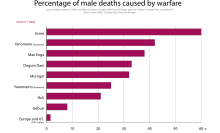Prehistoric warfare
[1][2] For the purposes of this article, "prehistoric war" will be broadly defined as a state of organized lethal aggression between autonomous preliterate communities.
[5] According to cultural anthropologist and ethnographer Raymond C. Kelly, population density among the earliest hunter-gatherer societies of Homo erectus was probably low enough to avoid armed conflict.
The need to prevent competition for resources by maintenance of low population densities may have accelerated the migration out of Africa of H. erectus some 1.8 million years ago as a natural consequence of conflict avoidance.
Hypotheses which suggest that genocidal violence may have caused the extinction of the Neanderthals have been offered by several authors,[7] including Jared Diamond[8] and Ronald Wright.
[11] Kelly believes that this period of "Paleolithic warlessness" persisted until well after the appearance of Homo sapiens some 315,000 years ago, ending only at the occurrence of economic and social shifts associated with sedentism, when new conditions incentivized organized raiding of settlements.
[12][13] None of the many cave paintings of the Upper Paleolithic depicts people attacking other people explicitly,[14][15] but there are depictions of human beings pierced with arrows both of the Aurignacian-Périgordian (roughly 30,000 years old) and the early Magdalenian (c. 17,000 years old), possibly representing "spontaneous confrontations over game resources" in which hostile trespassers were killed; however, other interpretations, including capital punishment, human sacrifice, assassination or systemic warfare cannot be ruled out.
[17] Furthermore, humans only began to bury their dead 150,000 years ago and not all cultures did so (some preferring to remove them by cremation or exposure), limiting remains that can be found.
[18] Kissel et al. argue that while the general scarcity of evidence from the period suggests warfare may not have been common, it does not support the hypothesis that war was absent.
[19] The most ancient archaeological record of what could have been a prehistoric massacre is at the site of Jebel Sahaba, committed against a population associated with the Qadan culture of far northern Sudan.
The co-occurrence of healed and unhealed lesions among 41 individuals was found to strongly support sporadic and recurrent violence between the social groups of the Nile valley.
[23] At the site of Nataruk in Turkana, Kenya, numerous 10,000-year-old human remains were found with possible evidence of major traumatic injuries, including obsidian bladelets embedded in the skeletons, that should have been lethal.
[24] According to the original study, published in January 2016, the region was a "fertile lakeshore landscape sustaining a substantial population of hunter-gatherers" where pottery had been found, suggesting storage of food and sedentism.
However, evidence of blunt-force cranial trauma and lack of interment have been called into question, casting doubt upon the assertion that the site represents early intragroup violence.
[36] Investigation of the Neolithic skeletons found in the Talheim Death pit in Germany suggests that prehistoric men from neighboring tribes were prepared to brutally fight and kill each other in order to capture and secure women.
[38][39] Other speculations about the reasons for violence among Linear Pottery Culture settlements in Neolithic Europe include vengeance, conflicts over land and resources, and kidnapping of slaves.
Some of these theories related to the lack of resources are supported by the discovery that various fortifications bordering indigenously inhabited areas appear to have not been in use for very long.
A mass burial site at Schletz was also fortified, which serves as evidence of violent conflict among tribes and means that these fortifications were built as a form of defense against aggressors.
[45] Bioarchaeologists have found from the skeletal remains of more than 2,300 early farmers from 180 sites in northwestern Europe between 8,000 and 4,000 years ago that more than one in ten suffered weapon injuries.
[46] During the period of expansion of hunter-gatherer groups associated with the Pitted Ware culture in southern Scandinavia, the Funnelbeaker farmers constructed a number of defensive palisades, which may mean that the two peoples were in conflict with each other.
[citation needed] Early Iron Age events like the Dorian invasion, Greek colonialism and their interaction with Phoenician and Etruscan forces lie within the prehistoric period.





